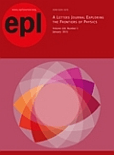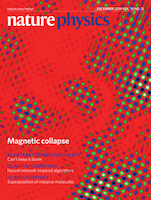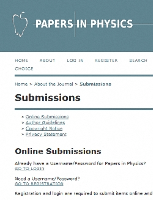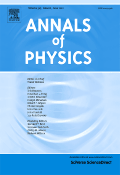
Condensed Matter Physics
Scope & Guideline
Empowering Researchers with Open Knowledge
Introduction
Aims and Scopes
- Theoretical and Computational Physics:
The journal publishes significant theoretical insights and computational studies, including first-principles calculations, Monte Carlo simulations, and molecular dynamics, which are essential for understanding complex phenomena in condensed matter systems. - Materials Science:
Research articles frequently explore the properties and applications of various materials, including ferroelectrics, superconductors, and nanostructures, providing insights into their electronic, thermal, and optical characteristics. - Soft and Biological Matter:
The journal includes studies on soft matter and biological systems, examining phenomena such as polymer dynamics, colloidal interactions, and biomolecular structures, which are critical for developing new materials and understanding biological processes. - Phase Transitions and Critical Phenomena:
Significant attention is given to phase transitions, critical phenomena, and statistical mechanics, exploring how systems behave near critical points and the implications for material properties. - Nanotechnology and Plasmonics:
Research on nanoscale materials, including the study of plasmonic effects in nanoparticles and their applications in photonics, is a consistent theme, reflecting the journal's commitment to advancing nanotechnology.
Trending and Emerging
- Complex Systems and Non-Equilibrium Dynamics:
Recent publications show a significant increase in research exploring complex systems and non-equilibrium dynamics, highlighting the importance of understanding systems that operate far from equilibrium, which is crucial for applications in materials science and biological processes. - Advances in Ferroelectrics and Multiferroics:
There is a notable trend towards investigating ferroelectric and multiferroic materials, driven by their potential applications in memory devices and sensors, reflecting a growing interest in materials with coupled electric and magnetic properties. - Quantum Materials and Topological Phases:
Research on quantum materials, including topological insulators and superconductors, has gained traction, emphasizing their unique properties and potential applications in quantum computing and advanced electronic devices. - Molecular Simulations in Soft Matter:
An increasing number of studies utilize molecular dynamics simulations to explore soft matter systems, such as polymers and colloids, indicating a trend towards detailed computational studies that complement experimental findings. - Nanostructured Materials and Plasmonics:
There is a rising interest in the study of nanostructured materials and their plasmonic properties, reflecting the relevance of these materials in developing next-generation photonic devices and sensing technologies.
Declining or Waning
- Classical Solid State Physics:
There has been a noticeable reduction in publications focusing solely on classical solid-state phenomena, such as traditional crystal structures and standard electronic properties, as the field increasingly shifts towards more complex systems and interdisciplinary approaches. - Low-Dimensional Systems:
Research specifically targeting low-dimensional materials, such as one-dimensional nanowires or two-dimensional materials, appears to be waning, possibly due to the saturation of foundational studies in this area. - Thermal Transport Studies:
Although still relevant, there has been a decline in the frequency of publications focused exclusively on thermal transport properties in materials, as more attention is directed towards integrated studies that combine thermal, electrical, and optical properties.
Similar Journals

ACTA PHYSICA SINICA
Advancing the Frontiers of Physics and AstronomyACTA PHYSICA SINICA is a prominent journal published by the Chinese Physical Society, dedicated to the dissemination of groundbreaking research in the field of physics and astronomy. Established in 1993, this journal has consistently contributed to the scientific community by publishing high-quality articles that cover a wide range of topics within general physics and related disciplines. Although currently classified in Q4 of the physics and astronomy category by Scopus, ACTA PHYSICA SINICA plays an important role in fostering collaboration and communication among researchers in China and around the world. With a substantial readership, this journal is poised to remain a valuable resource for professionals, researchers, and students alike. By providing in-depth analysis and insights, it aims to advance the understanding and application of physical principles in various technological and scientific advancements. The journal is accessible via subscription, ensuring that contributors and readers can engage with the evolving landscape of physics research. For more information, visit the publisher's website.

Annual Review of Condensed Matter Physics
Connecting Academia and Industry through Insightful ReviewsThe Annual Review of Condensed Matter Physics, published by Annual Reviews, is a leading journal dedicated to advancing understanding in the field of condensed matter physics and materials science. With an impact factor that reflects its esteemed position—ranking in the top quartile (Q1) across both condensed matter physics and miscellaneous materials science categories—this journal serves as a crucial resource for researchers and professionals seeking the latest insights and comprehensive reviews in these dynamic areas of study. The journal spans an impressive range of topics from theoretical developments to applied research, aiming to create a rich dialogue among academia and industry. With consistent publication from 2010 to 2024, it curates high-quality, peer-reviewed articles that set a benchmark for excellence in the scientific community. Engaging both established professionals and emerging scholars, the Annual Review of Condensed Matter Physics is pivotal in shaping the discourse and fostering innovation in condensed matter research.

European Physical Journal Plus
Fostering Collaboration in Physics, Astronomy, and Chemical EngineeringThe European Physical Journal Plus, published by Springer Heidelberg, is a reputable open-access journal that serves as a vital platform for innovative research across various disciplines, including physics, astronomy, and chemical engineering. With an impressive impact factor reflected by its Q2 ranking in both Fluid Flow and Transfer Processes and Physics and Astronomy (Miscellaneous) categories, this journal plays a crucial role in disseminating high-quality research findings. Since its inception in 2011, it has fostered interdisciplinary collaboration and encourages the exploration of fundamental principles and applications. The journal also boasts a respectable Scopus rank, indicating its solid influence and reach within the scientific community. Researchers, professionals, and students alike will find the journal to be an essential resource for staying abreast of advancements and trends in these dynamic fields, while its open-access model ensures that valuable insights are accessible to a broader audience.

EPL
Elevating Knowledge in Physics and AstronomyEPL, a prominent journal published by IOP Publishing Ltd, stands at the forefront of the field of Physics and Astronomy. With a history of impactful contributions stretching from 1986 to 2024, EPL serves as a dynamic platform for researchers to disseminate their pioneering findings and innovative ideas. The journal, with a current category ranking of Q2 among its peers and a competitive Scopus rank of #101 out of 243 in the general physics and astronomy category, reflects its substantial reputation and contribution to the scientific community. Although it operates under a traditional subscription model, EPL's reach is extensive, enabling access to a diverse readership that includes academicians, industry professionals, and students alike. By fostering interdisciplinary collaboration and promoting rigorous research, EPL continues to play a vital role in shaping the future of physics and astronomy.

REVISTA MEXICANA DE FISICA
Connecting Emerging Scholars with Established Research in PhysicsREVISTA MEXICANA DE FISICA is a prominent academic journal dedicated to advancing knowledge in the fields of Physics and Education. Published by the SOC MEXICANA FISICA, this journal plays a pivotal role in disseminating innovative research and educational methodologies from Mexico and beyond. With a publication history that spans from 1991 to 2024, it has established itself as an essential resource for researchers, professionals, and students who seek to deepen their understanding of general physics and astronomy. The journal is classified in the Q3 quartile in both education and physics & astronomy, showcasing its quality and relevance within the academic landscape. While the journal currently operates on a subscription basis, it provides a valuable platform for emerging voices and established scholars alike. By fostering a collaborative environment for scientific discourse, REVISTA MEXICANA DE FISICA continues to be an important channel for the ongoing evolution of scientific education and exploration in the physical sciences.

Nature Physics
Championing Excellence in Physics Research and CollaborationNature Physics is a premier journal dedicated to publishing high-impact research in the realm of physics, brought to you by the esteemed NATURE PORTFOLIO. With its ISSN 1745-2473 and E-ISSN 1745-2481, this journal has established itself as a vital resource for the physics community, enjoying a remarkable Q1 quartile ranking in the Physics and Astronomy category for 2023 and securing an impressive Rank #5/243 and a 98th percentile ranking in Scopus. Since its inception in 2005, Nature Physics has become a catalyst for innovation, featuring cutting-edge research that encompasses a broad spectrum of physics disciplines. Although it operates under traditional subscription models, it maintains a commitment to accessibility through selective publications and editorial excellence. Positioned in Berlin, Germany, this journal is a must-read for researchers, professionals, and students who seek to stay at the forefront of advancements in physics.

Papers in Physics
Unlocking the mysteries of the universe through interdisciplinary studies.Papers in Physics is a reputable, open-access journal dedicated to advancing knowledge in the diverse fields of physics, materials science, and theoretical chemistry. Published by the Instituto de Física Líquidos y Sistemas Biológicos in Argentina, this journal has been disseminating groundbreaking research since 2009 and has quickly established its place within the academic community. With a consistent commitment to accessibility, it serves as a vital resource for professionals, researchers, and students alike, enriching the discourse with innovative studies and findings. As recognized by its 2023 Scopus rankings, the journal occupies Q3 quartile positions across several categories, including Materials Science and Physics, illustrating its relevance and impact in the scientific landscape. The journal's breadth of research encompasses interdisciplinary approaches, fostering collaboration among scholars from various domains. Whether you are seeking to publish your own research or exploring the latest developments in physics and its related fields, Papers in Physics stands as a critical platform for the dissemination of knowledge and the advancement of science.

Annals of Physics
Exploring the universe of knowledge in Physics.Annals of Physics is a premier journal published by Academic Press Inc Elsevier Science, specializing in the expansive field of Physics and Astronomy. Since its inception in 1957, this journal has played a pivotal role in disseminating high-quality research and advancements across various sub-disciplines of physics. With a notable impact factor making it rank in the Q1 category for 2023, it stands among the top tier of scholarly publications, specifically sitting at Rank #63 out of 243 in the field, placing it in the 74th percentile according to Scopus metrics. Researchers are encouraged to submit their findings to reach a broad audience without the constraints of Open Access fees, promoting extensive visibility within the academic community. As we look ahead to 2024, Annals of Physics continues to be an essential resource for professionals, students, and academics striving to advance the frontiers of knowledge in physics and astronomy.

INDIAN JOURNAL OF PHYSICS
Championing Cutting-Edge Research in PhysicsINDIAN JOURNAL OF PHYSICS, published by the Indian Association for Cultivation of Science, serves as a pivotal platform for researchers and scholars in the field of physics and astronomy. With its ISSN 0973-1458 and E-ISSN 0974-9845, this journal is committed to presenting innovative research and developments across diverse topics in physics, covering both theoretical and experimental studies. The journal has made its mark in the academic community, evidenced by its classification in the Q3 category within the Physics and Astronomy domain as of 2023, and ranks #100 out of 243 in the Scopus curated database, placing it in the 59th percentile. Spanning from 2005 to 2024, the INDIAN JOURNAL OF PHYSICS aims to foster knowledge exchange and stimulate discussions among physicists and scientific enthusiasts. Whether you are a researcher looking to publish your findings, a professional seeking updates in your field, or a student eager to explore varying aspects of physics, this journal is an invaluable resource contributing significantly to the understanding and advancement of physics in India and beyond.

Frontiers of Physics
Connecting Ideas, Inspiring Physics ExcellenceFrontiers of Physics, published by Higher Education Press, is a premier open-access journal dedicated to fostering innovative research and excellence within the field of physics. With an ISSN of 2095-0462 and an E-ISSN of 2095-0470, this rapidly growing journal has established itself as a valuable platform for disseminating cutting-edge findings, covering a diverse range of topics from theoretical frameworks to experimental advancements. Notably, Frontiers of Physics has achieved an impressive Q1 ranking in the 2023 Scopus Quartiles for Physics and Astronomy, securing a competitive 5th out of 81 positions in its category, reflecting a high impact factor that underscores its importance to the scientific community. Since its inception in 2011 and continuing through 2024, the journal aims to bridge the gap between academia and industry, encouraging collaboration among researchers, professionals, and students alike. Its commitment to open access ensures that high-quality research is readily accessible, thereby promoting knowledge sharing and advancement in the global physics community. Explore the potential of your research in Frontiers of Physics, where the future of physics flourishes.